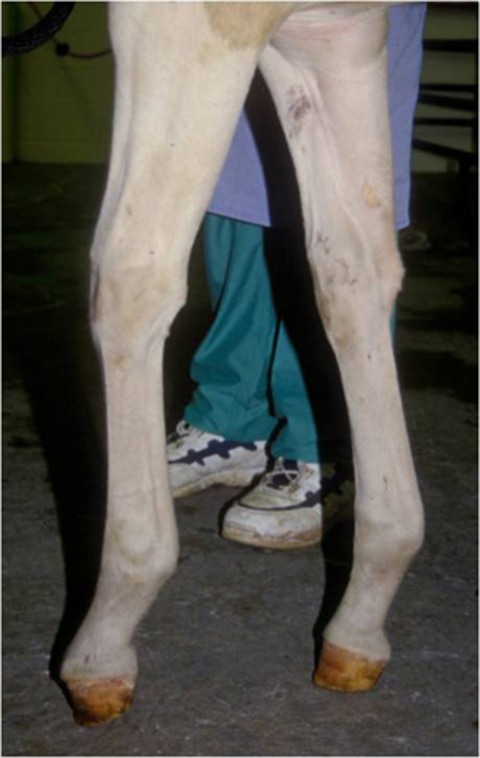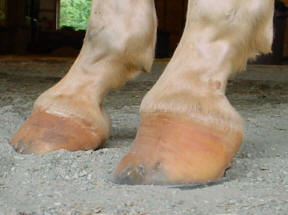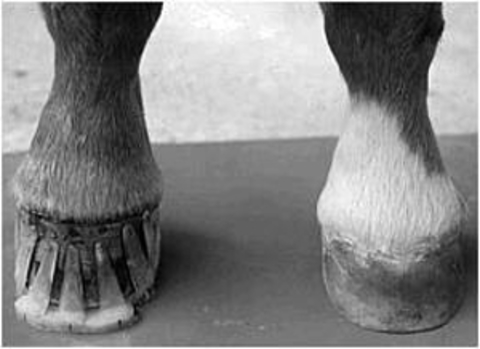club foot horse cause
Horses affected with club foot develop a flexural deformity of the coffin joint due to a shortening of the musculotendinous unit that starts high up in the limb and inserts on the coffin bone in the foot resulting in an upright conformation of the foot. Issue or it can occur later in life due to chronic lameness or injury that causes the horse to not bear weight fully.
What causes club foot in horses.

. Club foot refers to a tendon flaw that causes the hoof to be very upright. It can affect one or both limbs usually in the fore limbs. With respect to the club foot the heel of the affected foot grows faster and the hoof more upright in appearance due to most of the horses weight being placed.
You can fix everything else and still have the back of the foot too sensitive for the horse to land on which will cause the shortened stride and resulting club foot on its own another vicious cycle. When a club foot conformation is acquired in the adult horse it is almost always secondary to an underlying cause or disease such as an injury that results in a non-weight bearing lameness excessive trimming of the toe resulting in solar pain chronic low. The un-evenness in the stride and musculature will cause lameness because generally there is more stress placed on the club.
Club Foot Conformation in Horses. Read full answer here. The equine club foot is defined as a hoof angle greater than 60 degrees.
This lack of use may cause shortening and contracting of the muscles and tendons in that leg eventually making that foot more upright. Shortening of the tendon that is attached to the coffin bone. Young horses may develop a clubfoot in response to pain in the shoulder or elbow caused by osteochondritis dissecans OCD lesions a defect in the cartilage that affects the smooth action of the joint.
After birth foals acquire club feet when the bones grow faster than the tendons. If it is shod it will often forge or over reach and pull shoes off. The actual hoof will also be a size or two smaller than the other and a different.
A club foot may also result from injury if the horse is lame and keeps favoring the sore foot not putting much weight on the heel. Club foot can develop in mature horses too for similar reasons---any injury or chronic pain that causes a horse to consistently favor one foot can lead to contracting and shortening of the muscles and tendons specifically the deep digital flexor tendon and muscle apparatus in that leg eventually pulling the foot into a more upright position. But anything that makes the horse place more weight on its toe can cause a clubfoot.
The clinical presentation in the horse can range from a mildly upright and a small foot to one that is buckled for-ward with an angle greater than 90 at the distal. Yes club feet cause lameness. The horse is moving better but this could just be the eggbar shoes.
Coronary band may bulge as. Impacts the standing or movement of your young horse. Poor trimming can be corrected whereas a club foot cannot be corrected.
In the genetic club footed horse the cannon bone of the clubby foot is slightly shorter and so too is the tendon shorter than the normal leg. The club foot if not correctly balanced will cause problems such as contracted frogs and heels lameness from the high heels causing concussion from landing too early which also causes neck and shoulder and back strain. A horse with slightly asymmetrical feet is nothing out of the ordinary.
What we see externally as the equine clubbed foot is actually caused by a flexural deformity of the distal interphalangeal joint coffin joint. When hereditary in the horse however it is certainly a defect and is associated commonly with an upright limb and a short upright pastern see the picture on the right. The angles when the shoes were put on were 58 degrees on the club foot and 55 degrees on the under run footThe club foot was 3 the other front was 2 78 The shoes have been on about 2 weeks.
Foaling trauma foal grazing stance overly fast growth of limbs injury or even something as benign as over zealous cosmetic trimming of the toes of a foals hooves. A clubbed foot it a contracted tendon meaning that the leg with the club will not be able to reach as far. Causes of club foot Club foot has several possible causes.
Ance of the foot where there is little expansion of the hoof capsule giving a club-like appearance but this is an overly simplistic definition. Club foot can occur before or after birth in foals. It has even been said that horses which have a leaning posture or are in fact one-.
FIVE POTENTIAL CAUSES There are several theories on what can cause a club foot to occur. Causes include nutritional issues heredity position in the uterus or injury. Telltale signs of a club foot may include an excessively steep hoof angle a distended coronary band growth rings that are wider at the heels.
Often club foot affects both front legs with one being more severe than the other. Any club foot that has been around a while will have a sensitive unused underdeveloped frogdigital cushion. High heels in a normal hoof are very different from the high heels of a club foot and poor trimming does not result in a club foot.
Many stem from the understanding that situations limiting the range of movement in a horses limb can cause a hoof to grow more upright. But if one hoof differs dramatically from the other you might be dealing with a club footan abnormally upright hoof with. Club Foot Heritability in Horses.
Club foot is one of the most common deformities in the horse world. INJURY One of the more commonly accepted causes is the result of an injury most notably supra-scapular nerve damage. Caused by abnormal contraction of the deep digital flexor tendon a club foot puts pressure on the coffin joint and initiates a change in a hoofs biomechanics.
Treatment varies with the age of the horse and. If a horse puts more weight on the inside of a hoof the blood is pushed to the opposite side of the foot causing faster growth and wearing down the weighted surface at a faster rate. Causes of club-foot Upright hoof is undoubtedly hereditary and is even seen as a natural conformation in the feet of asses and mules.
Symptoms of Club Foot in Horses.
So Called Club Foot By James R Rooney Dmv
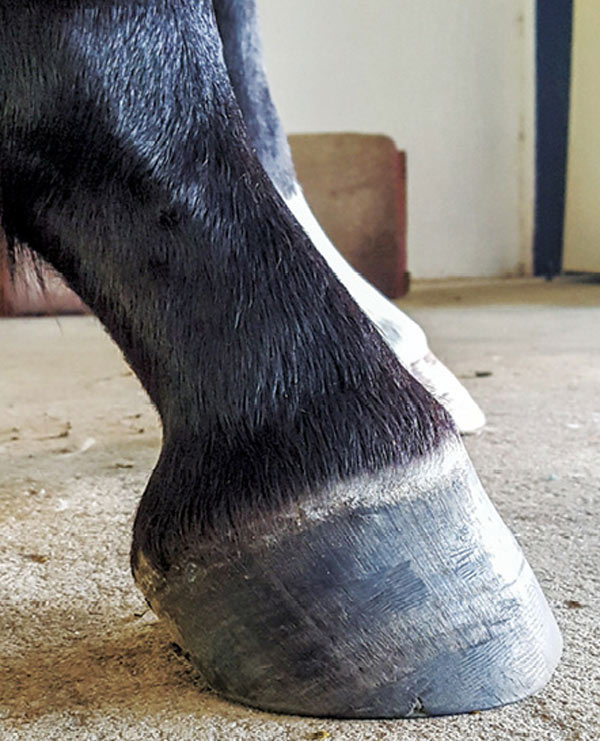
Club Foot Or Upright Foot It S All About The Angles
Club Foot In Horses Equine Chronicle
Equine Podiatry Dr Stephen O Grady Veterinarians Farriers Books Articles

Understanding Club Foot The Horse Owner S Resource
Is This A Club Foot Horsetalk Co Nz

Club Foot Or Upright Foot It S All About The Angles

Understanding Club Foot The Horse Owner S Resource

The Importance Of Physical Maturity In The Horse Horsetalk Co Nz

Ballerina Syndrome Where The Heels Remain Off The Ground Even At The Download Scientific Diagram

How D That Happen Origins And Remedies For Clubfoot Horse Racing News Paulick Report

Horse Care Horses And Dogs Horse Anatomy
Club Foot In Horses Equine Chronicle
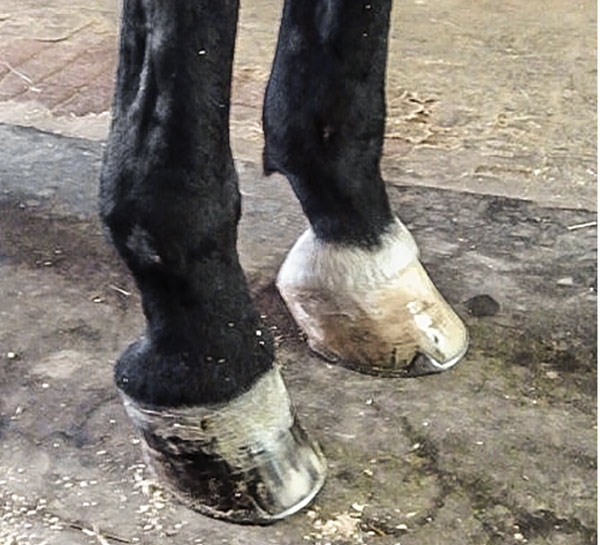
What Advice Has Been Most Helpful When You First Encounter A Club Foot

Club Foot In Horses Brian S Burks Fox Run Equine Center Facebook
